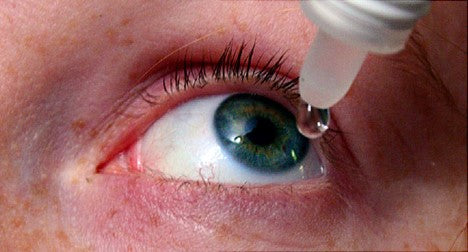When we talk about eye discomfort, the possible activities that induce stress to the eyes include extensive use of cell phones, working on the computer for longer periods, and the growing age of the people. Such factors led to dry and tired eyes, which influence eye health.
There are many ways to protect eyes from getting dried, such as a healthy diet that promotes the good health of the body system and improves eye health because the maintenance of good eye health requires minerals and vitamins to protect vision.
Restasis is one of the treatments of Chronic dry eyes, which mainly influences around 85% of the population who use computers and around 75 population of old age.
Chronic dry eye is one of the most common problems treated by ophthalmologists and optometrists. The prevalence of dry eye syndrome has been significantly increasing because of more socialization, play, and work that impacts eye health.
Types of Dry eye

Dry eye is mainly of two types:
1. Aqueous tear-deficient dry eye
This condition is also known as painful blindness dry eye because of the unavailability of tear glands. Tear glands are responsible for producing fluid components of tear for the proper cleaning of the eye surface.
This condition's potential cause is tearing gland damage due to environmental pollution, aging, and medicinal side effects.
2. Evaporative dry eye
This condition's potential cause is the inflammation of glands present in the eyelids, known as meibomian glands. The inflammation in the glands prevents the production of oil in sufficient amounts. However, such oil is known to be responsible for stopping tears from being evaporated quickly.
Symptoms
Despite known potential causes of this condition, the symptoms for identifying chronic dry eye are important. Some other causes contacts and allergic reactions.
Because many of the available treatment of this condition does not adequately address the problem's actual cause, this generally includes clogged tear glands inhibiting the production of oil, stress, and production of poor-quality tears.
The possible symptoms include redness, blurred vision, tired eyes, sensitivity to light, mucus in or around eyes, scratchy, pain, and dryness in eyes.
Some of the traditional treatment approaches for dry eyes mainly include managing prescription drugs, analogous serum drops, antibiotic drops, steroid drops, Restasis, and Xiidra. Despite the availability of such treatment drops, many of them contain preservatives that tend to irritate the skin further than relieving the dryness.
Supplements for dry eye
Concerning the scientific evidence, the intake of vitamin supplementation assists in treating dry eyes. However, daily intake of commercially available vitamin supplements has not been recommended to treat dry eye syndrome.
The importance of maintaining a healthy diet has been emphasized in some observational studies to help with dry eye conditions.
The possible supplements for dry eye treatment include the following:
1. Vitamin A
In the Community Eye Health Journal, it has been reported that dry eye condition is known to be associated with Vitamin A deficiency. The consumption of Vitamin A less than recommended amount led to the onset of dry eyes, night blindness, and other eye-related conditions, which tend to depend on the severity of deficiency.
A 2009 study based on the comparison of cyclosporine 0.05% (Restasis) and retinyl palmitate (Vitamin A) showed that both treatment options were found to be effective in treating dry eye disorder. It also brought improvement in the blurred vision of the patients.
A 2019 investigational study included Saudi Arabian men as the participants of the study. The test group of the experiment was provided with 1500mg of Vitamin A for oral consumption. The study results indicated that the intake of short-term supplements of Vitamin A significantly improved both the quantity and quality of tears in patients experiencing dry eyes.
2. Vitamin B
Like other Vitamins, the intake of Vitamin B has been reported to treat dry eye conditions.
B1:
In a 2020 randomized control study, oral vitamin B1 has been shown to relieve the symptoms associated with dry eye conditions. Such symptoms include pain, dryness, and photophobia, with a significant improvement in dry eye disease signs.
B2:
Vitamin B2 is generally known as riboflavin and tends to be beneficial for eye health. Vitamin B2 acts as a co-factor, particularly for antioxidants. It supports eye health and is used as an alternative supplement for eye fatigue.
B12:
The deficiency of Vitamin B12, like Vitamin A, also results in dry eye conditions.
According to a 2015 study, the participant was an Indian who reported a dramatic improvement in the pain symptoms in eyes with the intake of Vitamin B12 serum for three weeks. Within six months, the patient was reported to be free of symptoms.
3. Vitamin C and E

The use of vitamin supplements has known to be beneficial for people of old age.
Plants contain Vitamin C, and Vitamin E are known to contain compounds like lutein, zeaxanthin, minerals such as copper and zinc help prevent eye-related medical conditions from the development of age-related macular degeneration (AMD).
Vitamin C's potential sources mainly include apples, bananas, tomatoes, cooked spinach, oranges, grapefruit juice, and orange juice.
The average intake of vitamin C content for women is around 75 milligrams per day, whereas men's requirement is a bit more than women's, i.e., around 90 milligrams per day.
4. Vitamin D
The antioxidant properties in Vitamin D help in the protection of eye cells from damage. Vitamin D also plays an important role in boosting the immune system. Vitamin D's common sources are wheat cereal, sweet potato, hazelnuts, peanut butter, almonds, and sunflower seeds.
In the International Journal of Rheumatic Diseases, it has been reported that there is an association of dry eye condition with Vitamin D. Impaired tear function and dry eye condition are known as the occasional symptoms of the deficiency of Vitamin D.
Vitamin D plays an important role in protecting against dry eye conditions through improvement in factors associated with the tears coating covering the front of the eye.
Vitamin D also helps in the reduction of inflammation on the eye surface. It has also been suggested that the intake of Vitamin D supplements helps relieve the symptoms of dry eye. However, there is a need for further confirmation of the effect of Vitamin D.
5. Lutein
Lutein is an antioxidant found in plants that cut the odds of having different chronic dry eye conditions. Lutein helps in the maintenance of the health of eye cells and improves their functioning.
Among the local treatment approaches of dry eye conditions, lutein serves as a promising agent.
According to a 2015 study, the doctors in Taiwan found that lutein helps reduce inflammation in the cornea's epithelial cells. The layer of such cells is known to provide protection to the front of the eyes and reduce dry eye symptoms.
6. Saffron

According to a randomized control trial, it has been reported that the use of saffron supplementation brings significant improvement in the functions of the retina. The daily intake of Saffron supplementation was 30mg for about 6 months. However, further research needs to be conducted about saffron supplementation for clinical practice for dry eye treatment.
In the Italian Journal of Medicine, the impact of saffron supplementation was evaluated to treat dry eye conditions. The consumption of saffron slowed down the disease progression and resulted in significant vision and contrast sensitivity improvement.
7. Zinc
Zinc is considered one of the essential minerals that help in utilizing Vitamin A from the liver by the retina to produce melanin. This pigment is mainly required for eye protection. The consumption of Zinc in less amount than recommended is known to increase the risk of eye infection.
The intake of zinc is important because it is not synthesized naturally in the human body.
8. Omega-3 Fatty acids

Polyunsaturated fat has great importance in the body system's functioning, which mainly includes omega-3 fatty acids. A type of omega-3 fatty acid is found in high concentration in the retina's cell membrane in the form of DHA.
According to a 2011 study about retina and omega-3, one of the potential benefits of omega-3 fatty acid is primarily in treating dry eye condition as it helps in the increased production of tears because the affected production of tears might lead to the development of dryness, discomfort, and blurred vision in the eyes.
In the randomized control trial, it has also been suggested that the intake of omega-3 supplements helps patients to reduce symptoms of the dry eye disease condition.
In another randomized control trial, patients suffering from dry eye conditions significantly revealed DHA and EPA daily supplements' impact. The study results showed a reduction in the symptoms of dry eye condition followed by increased production of tear fluid.
In a 2005 clinical trial, it has been suggested that a higher intake of omega-3 fatty acid reduces the risk associated with the development incidence of dry eye condition in women.
The omega-3 fatty acid has been known to relieve the symptoms of dry eye conditions. According to National Eye Institute, the effect of omega-3 fatty acid was analyzed for patients with dry eye conditions. The outcomes of the study concluded that the participants of the study who were given 3000mg of omega-3 fatty acid showed no justifiable results as compared to those patients who were given an olive oil placebo.
Thus, it can be said that olive oil supplementation can also be used to treat dry eyes. But the evaluation of the impact of omega-3 fatty acid is further needed for confirmation of its action in future studies.
9. Gamma-Linolenic Acid
Fatty acids are not limited to omega-3, but omega-6 fatty acid is also an active ingredient in the modern diet, i.e., Gamma-linolenic acid (GLA).
Although the intake of omega-6 fatty acid is not known to be highly effective in treating conditions like dry eye, it tends to have anti-inflammatory properties.
The possible sources to take GLA in the diet include starflower oil and evening primrose oil.
It has been suggested that the consumption of evening primrose oil might reduce dry eye disease symptoms.
According to a randomized control trial, the study provided evidence associated with the benefits of omega-6 fatty acid. The study participant was provided with a daily dose of 300mg of GLA in the form of evening primrose oil. The study results showed that oral administration of omega-6 fatty acid alleviated dry eye symptoms and brought significant improvement in eye comfort in patients suffering from a dry eye condition.
The Bottom Line
The maintenance of healthy eating and lifestyle habits such as the selection of food and regular exercise helps prevent the occurrence of a wide range of disease conditions such as eye conditions.
The intake of natural supplements helps in reducing the possible risk of eye disease and maintain eye health. Many vitamins play their specified role in improving dry eye conditions.
Consuming the combination of vitamins in the form of a vitamin supplement would help meet the daily needs of vitamins and reduce the risk of the disease condition. Similarly, it would also improve the vision.
Also, stress conditions induce more hunger in some people, which leads to disturbed eating habits. The focus of people is more towards fulfilling their hunger needs rather than eating healthy to stay healthy. Natural supplements help maintain a healthy weight and improve eyes' conditions, such as dry eye or macular degeneration.
Thus, value the body's basic needs by providing it all the basic vitamins and minerals it needs to keep the whole body healthy.


